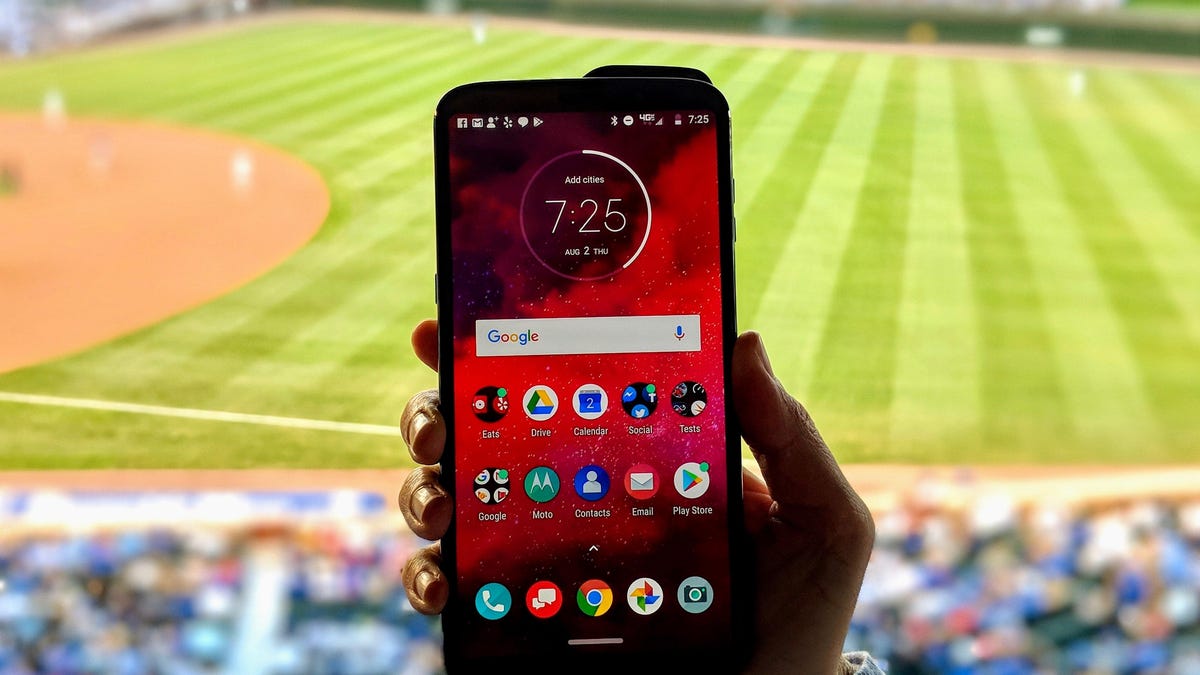Why the Moto Z3 has a 5G Mod instead of 5G inside
Verizon and Motorola can now claim being the 'first' to 5G when the time comes, but is it the right move?

Motorola and Verizon are betting so big on 5G, they're trying to sell you a 4G phone today on the promise of blazing-fast 5G speeds that don't yet exist.
Motorola's 5G Mod, in prototype form.
Last week, the phonemaker and wireless carrier teamed up in Chicago to announce the Moto Z3, a Verizon exclusive and the first phone to be upgradable to 5G when Verizon turns on its first 5G networks in early 2019.
When you snap on a 5G modular attachment, Motorola says that its Z3 phone will deliver data 10 times faster than other 4G LTE devices at speeds up to 5Gbps (5 gigabits per second).
But the Moto Z3 is not a 5G phone on its own. It won't suddenly metamorphize from a 4G handset into a 5G butterfly the second Verizon's network becomes available.
Right now, the Z3 only contains the right technology to access 4G data speeds. Rather, the Moto Z3 will achieve 5G speeds solely through the 5G Moto Mod that consumers can buy no sooner than early next year.
See, without having the Moto 5G Mod available now, the Moto Z3 is just another 4G phone, albeit one with magnetic pins that seamlessly connect to a variety of Mods, from battery packs and portable speakers to an array of colorful backings. The 5G Mod, meanwhile, is a clunky slug of plastic in prototype form, even if it did impress a roomful of journalists (who were barred from photographing the demo) with extremely fast speeds -- in a controlled testing environment.
The demos and prototype both raise the question: why tout 5G now on a phone that doesn't even have 5G? Wouldn't it be smarter for Motorola to wait until Verizon is ready to flip the switch on 5G, and then announce a 5G-capable phone with 5G already built in to every phone?
Motorola's answer is two-fold.
"Our goal with 5G was to be industry-first," said Doug Michau, Motorola Mobility's director of technical sales and operations, during an interview with CNET.
The importance of getting a leg up on 5G before 5G networks even exist can't be overstated. 5G, the next generation of wireless data technology, will increase upload and download speeds by an order of magnitude, and will help devices talk to each other almost instantaneously.
Industry leaders are confident that 5G will change the way cities are run, classrooms operate and companies do business. The wireless networks and devices that can secure an early lead in providing reliable 5G networks and devices can draw more customers who are hungry to for ridiculously fast data. Winning at 5G is an enormous business advantage.
The second reason for Motorola's decision to embrace a 5G Moto Mod rather than to make the phone 5G-ready comes down to design constraints. The 5G Mod prototype is a thick attachment that's stuffed with four antenna modules which, together, make those speed gains work using a variation of 5G technology called millimeter-wave.
"If we did put [5G] in the cell phone, it wouldn't be early 2019, it would be much later," Michau said. "The four antenna modules use up a lot of space...and if you put them all in the phone, you'd wind up with a thicker phone with a much smaller screen."
In the meantime, Michau says that Motorola's working on a different type of 5G technology that could go directly into a device. This sub-6GHz form of 5G would be able to keep phones from becoming thick with extra parts, Michau said.
As for how long we'd have to wait to see those phones ready for the market? "Definitely less than three years, but no time frame yet," Michau said.
It still isn't completely clear if the 5G Moto Mod will work with other phones in the Moto Z family or just with the Moto Z3, through its exclusive with Verizon's network. What is clear is that Motorola wants to beat better-selling brands like the iPhone and Samsung Galaxy phones to the 5G age.
Read now: Moto Z3 will be the first phone to use 5G...in 2019
Read next: What's 5G? Here's what you need to know

